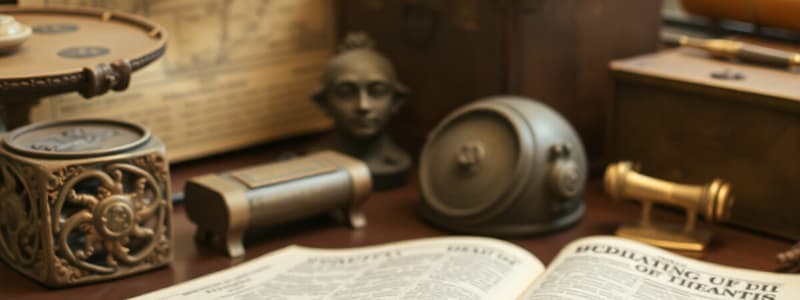Podcast
Questions and Answers
A historian is studying the economic impact of a newly discovered ancient coin on a particular civilization. Which type of historical data would be MOST relevant?
A historian is studying the economic impact of a newly discovered ancient coin on a particular civilization. Which type of historical data would be MOST relevant?
- Oral testimonies describing the coin's discovery.
- Written accounts detailing trade routes and currency values.
- Biographies of rulers during the coin's era.
- The coin itself, as a physical artifact. (correct)
A researcher aims to understand the daily life of Roman soldiers. Which combination of historical data sources would provide the MOST comprehensive insight?
A researcher aims to understand the daily life of Roman soldiers. Which combination of historical data sources would provide the MOST comprehensive insight?
- Relics of religious symbols and diplomatic correspondence.
- Artifacts such as tools and weapons, alongside personal letters and journals. (correct)
- Speeches by emperors and scientific tracts on military strategy.
- Narrative literature and social documents from conquered territories.
An anthropologist is investigating a pre-literate society. Which type of historical data would be MOST valuable?
An anthropologist is investigating a pre-literate society. Which type of historical data would be MOST valuable?
- Diplomatic sources detailing treaties with other societies.
- Narrative accounts passed down through generations.
- Artifacts such as tools, pottery, and skeletal remains. (correct)
- Written testimonies collected from neighboring cultures.
A scholar is researching the role of public opinion during a political movement. Which of the following written sources would be MOST relevant?
A scholar is researching the role of public opinion during a political movement. Which of the following written sources would be MOST relevant?
Which of the following historical sources would be most useful in understanding the personal motivations behind the actions of a specific leader in history?
Which of the following historical sources would be most useful in understanding the personal motivations behind the actions of a specific leader in history?
A historian is studying a peace treaty between two warring nations. Which type of written source would this treaty be categorized as?
A historian is studying a peace treaty between two warring nations. Which type of written source would this treaty be categorized as?
A movie producer wants to create a historically accurate film about the life of Queen Victoria. Beyond narrative accounts, which source would provide nuanced details about her personal life?
A movie producer wants to create a historically accurate film about the life of Queen Victoria. Beyond narrative accounts, which source would provide nuanced details about her personal life?
Which of the following is NOT a characteristic of testimonies as historical data?
Which of the following is NOT a characteristic of testimonies as historical data?
Which characteristic is LEAST useful when authenticating a charter as a diplomatic source?
Which characteristic is LEAST useful when authenticating a charter as a diplomatic source?
Which of the following BEST exemplifies a social document?
Which of the following BEST exemplifies a social document?
A historian is studying the economic conditions of a pre-colonial village. Which of the following would be the LEAST useful material evidence?
A historian is studying the economic conditions of a pre-colonial village. Which of the following would be the LEAST useful material evidence?
How do primary sources MOST directly contribute to historical understanding?
How do primary sources MOST directly contribute to historical understanding?
Which scenario BEST exemplifies the use of oral evidence in historical research?
Which scenario BEST exemplifies the use of oral evidence in historical research?
A researcher is writing a biography of a famous general. Which source would be considered a secondary source?
A researcher is writing a biography of a famous general. Which source would be considered a secondary source?
How can historians BEST utilize artistic creations/artifacts in understanding the past?
How can historians BEST utilize artistic creations/artifacts in understanding the past?
Which of the following research projects would benefit MOST from analyzing both written and unwritten sources?
Which of the following research projects would benefit MOST from analyzing both written and unwritten sources?
Flashcards
Historical Data
Historical Data
Information, records, or evidence from the past used to study historical events, cultures, and societies.
Artifacts
Artifacts
Physical objects created or used by humans, providing evidence of past cultures and technologies.
Relics
Relics
Objects or remains from the past valued for their historical, cultural, or religious significance.
Testimonies
Testimonies
Signup and view all the flashcards
Written Sources
Written Sources
Signup and view all the flashcards
Narrative or Literary Sources
Narrative or Literary Sources
Signup and view all the flashcards
Scientific tract
Scientific tract
Signup and view all the flashcards
Diplomatic sources
Diplomatic sources
Signup and view all the flashcards
Charter
Charter
Signup and view all the flashcards
Social Documents
Social Documents
Signup and view all the flashcards
Material Evidence
Material Evidence
Signup and view all the flashcards
Oral Evidence
Oral Evidence
Signup and view all the flashcards
Historical Sources
Historical Sources
Signup and view all the flashcards
Primary Sources
Primary Sources
Signup and view all the flashcards
Secondary Sources
Secondary Sources
Signup and view all the flashcards
Artistic Creations/Artifacts
Artistic Creations/Artifacts
Signup and view all the flashcards
Study Notes
Historical Data
- Historical data includes information, records, and evidence from the past.
- It enables the analysis, study, and interpretation of historical events, cultures, and societies.
- This data forms the foundation of historical research.
- It helps historians reconstruct and understand past events.
- Historical data originates from artifacts (relics, remains) and testimonies.
- These sources give historians the ability to construct meaning and interpretations of past events.
Types of Historical Data
Artifacts
- Artifacts are human-created or used physical objects.
- They offer tangible evidence of past cultures, technologies, and daily life.
- Tools, pottery, weapons, and coins are examples.
Relics
- Relics consist of objects or remains surviving from the past.
- They are often valued for their historical, cultural, or religious significance.
- Sacred texts, bones of saints, jewelry, and clothing are examples.
Testimonies
- Testimonies are historical data that include firsthand or secondhand accounts of past events.
- These accounts come from individuals who witnessed or experienced those events.
- Testimonies may be oral (spoken) or written.
- Interviews, speeches, and recorded testimonies are examples of oral testimonies.
- Journals, letters, autobiographies, and official records are examples of written testimonies.
Sources of History
- Written and non-written sources of history exist.
Written Sources of History
- Written sources are usually categorized into narrative or literary, diplomatic or juridical, and social documents.
Narrative or Literature
- Narrative, or literature consists of chronicles or tracts presented in narrative form, written to impart a message whose motives for their composition vary widely.
- Scientific tracts inform contemporaries or succeeding generations.
- Newspaper articles shape opinion.
- Ego documents (diaries, memoirs) persuade readers of the justice of the author's actions.
- Novels or films entertain, deliver moral teachings, or further religious causes.
- Biographies praise the subject's worth and achievements.
Diplomatic Sources
- Diplomatic sources were once considered the purest and "best" source by professional historians.
- Charters (permission slips) or legal instruments are sealed, meaning the document is authenticated.
- They provide evidence that a legal transaction has been completed.
- It can be used as evidence in judicial proceedings.
- They are issued by authorities such as kings, popes, the Supreme Court of the Philippines, and the Philippine Congress.
- Specific formal properties include hand and print style, ink, the seal, and rhetorical devices and images.
- They vary in time and according to origin; each generation possesses its own norms, and each bureaucracy has its own traditions.
Social Documents
- Social documents contain information related to economic, social, political, or judicial significance.
- Bureaucracies keep these records.
- Government reports, municipal accounts, research findings, parliamentary procedures, civil registry records, property registers, and records of census are examples of such documents.
Non-Written Sources of History
- Unwritten sources are as essential as written sources.
- They include material evidence and oral evidence.
Material Evidence
- Also known as archaeological evidence, is a crucial form of unwritten evidence.
- Artistic creations/artifacts, pottery, jewelry, dwellings, graves, churches, and roads tell stories of the past.
- Drawings, etchings, paintings, films, and photographs are visual representations of the past.
Oral Evidence
- Is an important source of information for historians.
- Tales, sagas of ancient peoples, folk songs, and rituals are examples from the premodern period of Philippine history.
- Interviews are another major form of oral evidence in the present age.
Historical Sources
- These are materials historians use to learn about the past.
Primary Sources
- Primary Sources are original records of an event by people who experienced or witnessed it.
- Letters, diaries, journals, newspaper articles, government documents, photographs, and creative outputs are examples.
Secondary Sources
- Secondary sources analyze and interpret primary sources; a second-hand account of a historical event.
- Biographies, histories, literary criticism, and books written by a third party about a historical event are examples.
Studying That Suits You
Use AI to generate personalized quizzes and flashcards to suit your learning preferences.




